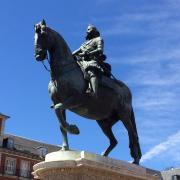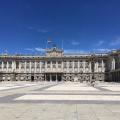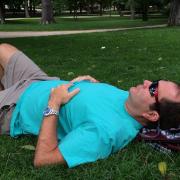 Overview
Overview
We didn’t fall in love immediately with Madrid. The city had to seduce us. We found Spain’s capital to be big and busy and very unlike the rest of Spain, meaning Madrid isn’t exactly laid back. But after a few days Madrid’s charms sank in, about when–the second evening in a row–we were enjoying a bottle of wine in one of Madrid’s splendid parks after a day of wandering through plazas and sampling tapas at the market.
So when you go, expect the big city experience to start with, but let the city calm and slow you: slip into the practice of afternoon siesta. See all the sites in the mornings or in the early evenings, especially if you’re visiting during the summer when it’s hot, and take it easy, like the Madrileño’s, in the afternoons and late evenings.
What to See in Madrid
 A few of our absolute favorite sites to see in Madrid are free, like the awesome Mercado San Miguel (Market of Saint Michael), where locals come to buy fresh fish, meats, and cheese; you can stop at a counter and enjoy a wine and tapas lunch for €10 or less (depending on how many glasses of wine you have). Nearby are the Plaza Mayor and Puerta del Sol, where you’ll find statues of Phillipe III (former) and a bear picking strawberries (latter). Madrid offers two awesome art museums: the Museo Nacional del Prado (simply, The Prado) and it’s collection of classical art, particularly works of Goya and Valezquez, and the Museo Nacional Centro de Arte Reina Sofia (simply, The Reina Sofia) and it’s modern art collection, including Picasso’s Guernica.
A few of our absolute favorite sites to see in Madrid are free, like the awesome Mercado San Miguel (Market of Saint Michael), where locals come to buy fresh fish, meats, and cheese; you can stop at a counter and enjoy a wine and tapas lunch for €10 or less (depending on how many glasses of wine you have). Nearby are the Plaza Mayor and Puerta del Sol, where you’ll find statues of Phillipe III (former) and a bear picking strawberries (latter). Madrid offers two awesome art museums: the Museo Nacional del Prado (simply, The Prado) and it’s collection of classical art, particularly works of Goya and Valezquez, and the Museo Nacional Centro de Arte Reina Sofia (simply, The Reina Sofia) and it’s modern art collection, including Picasso’s Guernica. Both museums open their doors for free entry the last two hours of the day, and Reina Sofia is closed on Tuesdays.
Both museums open their doors for free entry the last two hours of the day, and Reina Sofia is closed on Tuesdays.
A big must-see in Madrid is the Royal Palace of Madrid. The still-operating palace of the Spanish monarchy, we think, is a better European palace experience than France’s Versailles (Gasp! though the Spanish palace completely lacks any grounds and gardens). Like the art museums, the palace offers free entry the last two hours of the day, but you’ll really need 3 hours to tour it completely, especially if you also want to see the adjacent military museum. Across the plaza you’ll find Madrid’s Cathedral, the Catedral de la Almudena, a beautiful 20th century cathedral (Pope John Paul II consecrated it ) with classical lines and modern art. There are many other museums, palaces, and churches to see in Madrid, but one thing you’ll definitely want to do is wind down–perhaps with a picnic and a bottle of wine–in Madrid’s Retiro Park (Parque del Retiro), where you can rent a rowboat in the pond and warm yourself in the Crystal Palace.
) with classical lines and modern art. There are many other museums, palaces, and churches to see in Madrid, but one thing you’ll definitely want to do is wind down–perhaps with a picnic and a bottle of wine–in Madrid’s Retiro Park (Parque del Retiro), where you can rent a rowboat in the pond and warm yourself in the Crystal Palace.
Where to Stay in Madrid
There are dozens of hotels along the stately Gran Via, ranging from budget accommodations at $50 a night to luxury accommodations at $500 a night. Hotels on the Gran Via are generally going to be convenient to many of the sites we describe above, particularly the palace, cathedral, Plaza Mayor and Mercado San Miguel. Madrid’s subway system is efficient and extensive, with easy access from the Gran Via area.
When it comes to peer-to-peer lodging, AirBnB and HomeAway.com boast thousands of listings from shared rooms to grand villas. The thing to keep in mind is: where is the listing located? Madrid is a big city, with many great neighborhoods, but if it’s your first visit and you’ve only got a few days to a week, consider staying in the heart of the city.
What and Where to Eat in Madrid
 Our absolute favorite eating experience in Madrid is the Mercado San Miquel as we described above. Among the stalls and booths selling meats, fruits, veggies, and more you’ll find tapas and wine vendors. Just place your order by pointing (if their English isn’t good) and remember “vino tinto” is red wine, “vino blanco” is white wine, and “rosado” is rosé. Say “copa?” for a glass, “liter” for a pitcher.
Our absolute favorite eating experience in Madrid is the Mercado San Miquel as we described above. Among the stalls and booths selling meats, fruits, veggies, and more you’ll find tapas and wine vendors. Just place your order by pointing (if their English isn’t good) and remember “vino tinto” is red wine, “vino blanco” is white wine, and “rosado” is rosé. Say “copa?” for a glass, “liter” for a pitcher.
Madrid also offers hundreds (thousands?) of cafés, especially in and around the Plaza areas. Tapas and wine are the big things, but you might also be tempted by the sumptuous smell of grilled meats from time to time. Paellas are common, as are the universally appealing pizza. On many menus you’ll see something called a “Spanish Omelette”, or “Tortilla Español”: it’s more like a quiche with potatoes than the omelette you might expect (if you can find it stuffed with chorizo, and you’re a carnivore, give it a try). Finally, taking a stroll down the Gran Via or the Calle Mayor you’ll find great places for nibbles and cheap buckets of beer: wonderful on a hot summer afternoon.
 Don’t forget to indulge in siesta!
Don’t forget to indulge in siesta!






